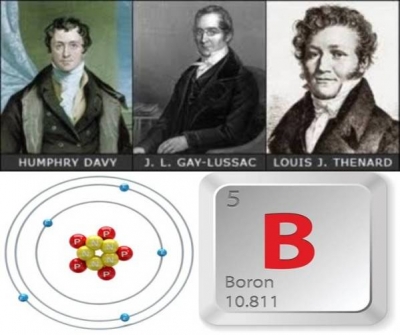
The element whose atomic number is 5 is called boron. It was partially isolated by Joseph L. Gay-Lussac and L. J. Thenard, two French Scientists and independently by Sir Humphry Davy in London. Gay-Lussac and Thenard made boron by reacting boric acid with magnesium and sodium. Boron was yielded as a grey solid. They named it bore as they thought it shared its characteristics with sulphur and phosphorous.
Sir Humphry Davy tried to produce boron by the electrolysis of boric acid first, but he was not satisfied with the results. Later, he reacted boric acid with potassium in a hydrogen atmosphere, which produced a powdery substance. Davy commented that this substance was ‘of the darkest shades of olive’, was of unknown origin or very dark, very friable, and that it does not scratch glass. But the truth was, none of these scientists had produced pure boron. Their samples were only 60 per cent pure. It was only in 1909 that 99 per cent pure boron was produced by distilling boron halides with hydrogen. This was done by an American chemist named Ezekiel Weintraub.
Compounds of boron such as borax (sodium tetraborate) were known and used by ancient cultures for thousands of years. Borax is named after the Arabic word buraq, which means white.
Boron is very hard, toxic and resistant to heat. It is an essential nutrient for all green plants. Being an excellent neutron absorber, it is used to control nuclear reactions. When made into an alloy with steel, or combined with carbon, titanium or zirconium, boron becomes excellent control rods for nuclear reactors. Boron compounds burn with a green flame, which leads to their use in fireworks.
Picture Credit : Google




